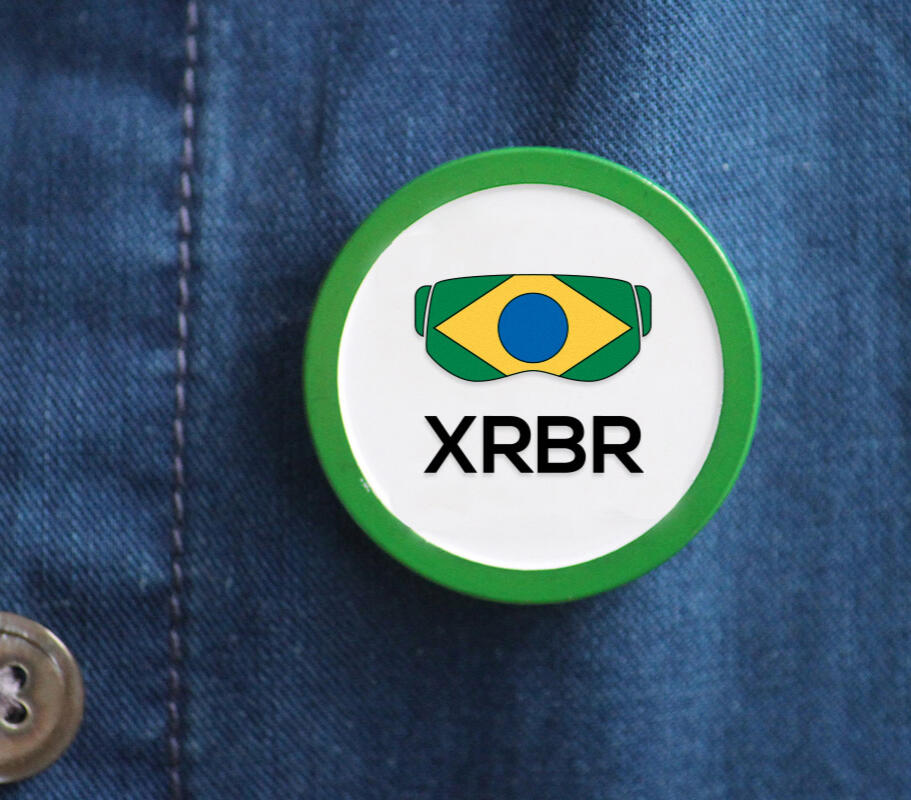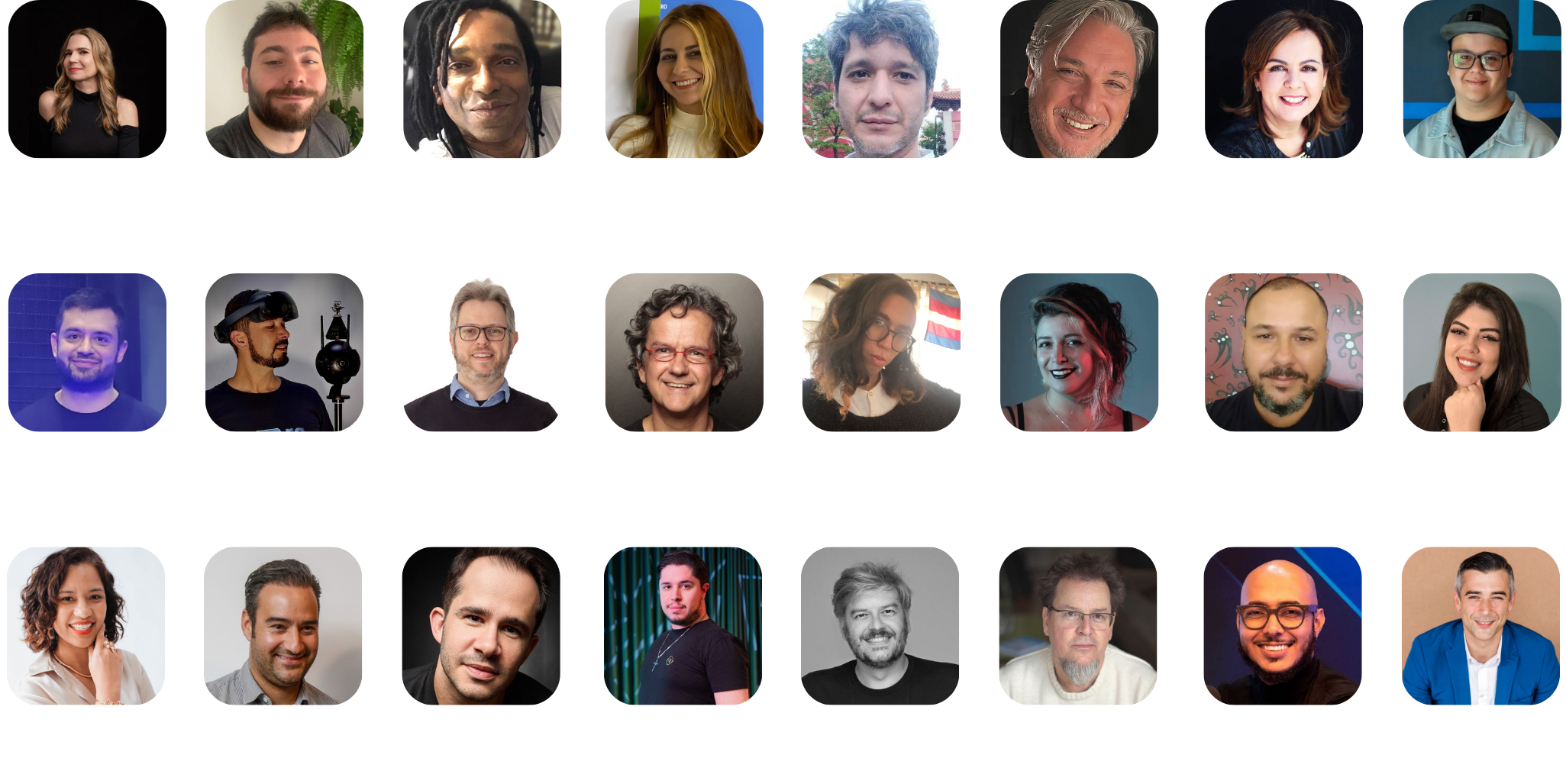


Quem Somos
XRBRNo final de 2017 várias iniciativas para criar uma comunidade brasileira de empresas e profissionais atuantes no mercado de X-Reality (Realidade Virtual, Realidade Aumentada e Realidade Mista – conhecidos como XR) se uniram para criar o principal canal de fomento global da indústria brasileira de XR.


Calendário
Encontre eventos relacionados a XRAqui você vai encontrar eventos relacionados a XR em todo o mundo. Estes são eventos promovidos por entidades de relevância e identificados por membros da XRBR. Para informações mais detalhadas, basta clicar no evento.Com o surto do COVID-19, muitos dos eventos foram cancelados ou transformados em eventos online. Com isto mantivemos o calendário ativo como referência para eventual pesquisa.
Ecossistema
Ecossistema XRBRSer um associado XRBR é ter acesso a um networking de empresas e profissionais de nível internacional, acesso exclusivo a oportunidades de negócios e descontos em eventos da área. São inúmeros benefícios!

Manifesto
Comunidade brasileira de empresas e profissionais atuantes no mercado de X-Reality
No final de 2017 várias iniciativas para criar uma comunidade brasileira de empresas e profissionais atuantes no mercado de X-Reality (Realidade Virtual, Realidade Aumentada e Realidade Mista – conhecidos como XR) se uniram para criar o principal canal de fomento global da indústria brasileira de XR.
Em 20/02/2018 nasceu o XRBR | Hub Brasileiro de X-Reality.O XRBR é, desde Fevereiro de 2019, uma associação formal sem fins lucrativos. Criada por profissionais e apoiado por empresas de forma totalmente voluntária e apaixonada para unir esforços e impulsionar este emergente e desafiador mercado brasileiro.Somos abertos a todos, acreditamos na união e colaboração pessoais e corporativas, e temos um mesmo sonho: conectar todos os elos da cadeia criativa e produtiva para que as empresas brasileiras sejam as melhores do mundo em VR/AR/MR.
Fundadores
- Alexandre Calil
- Aline Pina
- Anesio Neto
- Bruno Pedroza
- Daniel Sasso
- Eliza Flores
- Fabio Hofnik
- Flávio Mayerhofer
- Francisco Almendra
- Igor Sales
- Ines Maciel
- Jorge Groove
- Karina Israel
- Leonardo Ferro
- Marcos Alves
- Marcos Trinca
- Mario Di Poi
- Paolo La Rosa
- Priscila Guedes
- Rawlinson Terrabuio
- Ricardo Lebre
- Rodrigo Arnaut
- Rodrigo Terra
- Simone Kliass
- Tadeu Junge
Visão
Ser o principal canal de fomento global da indústria brasileira de X-Reality (VR/AR/MR), tornando-se um forte aliado das empresas, profissionais e organismos de investimentos privados e públicos. Com o objetivo de crescer e amadurecer o mercado, com ampliação do alcance.
Missão
Apoiar o desenvolvimento de empresas, com atuação no Brasil, que ofereçam produtos e/ou serviços nos segmentos de Realidades Virtual, Aumentada, Mista ou novas que surjam, denominadas X-Reality.
Organizar, coordenar, fortalecer e promover o crescimento do setor através da integração com o ecossistema nacional e internacional.Fomentar nacional e internacionalmente a identidade criativa brasileira no segmento.Democratizar o acesso de audiências, empresas e profissionais às inovações tecnológicas e novos paradigmas criados pela X-Reality.
Objetivos
Criar um ambiente de troca de experiências entre os associados! Assim como com ecossistemas nacionais e internacionais do segmento, promovendo amadurecimento, crescimento, identificação de sinergias e geração de negócios.
Promover, nos mercados nacional e internacional, os produtos e serviços do associados.Apoiar iniciativas de exportação de serviços e internacionalização das empresas brasileiras. Através de conexões com investidores, centros de pesquisa, hubs de inovação e órgãos de fomento para criação de programas específicos para este fim.Apoiar os associados no acesso a investimentos privados e públicos, nacionais ou internacionais.Interlocução com governo e academia para fomentar o crescimento do setor e desenvolver novas oportunidades de trabalho.Desenvolvimento de estudos e pesquisas, tanto para a informação da sociedade quanto para a qualificação dos profissionais interessados.E reforçando nossa visão, ser o principal canal de fomento global da indústria brasileira de XR!
Seja um associado
Ser um associado XRBR é ter acesso a um networking de empresas e profissionais de nível internacional, acesso exclusivo a oportunidades de negócios e descontos em eventos da área. São inúmeros benefícios!
Quem Somos
Somos um grupo de empresas e profissionais apaixonados por mídias imersivas

A missão da XRBR – Associação Brasileira de Realidade Estendida
É fortalecer o mercado de XR no Brasil compartilhando conhecimento e oportunidades entre empresas e especialistas do setor. Criada em 2017 como hub de negócios, e formalizada em 2018 como associação setorial, a XRBR é um espaço de colaboração sobre novas tecnologias de interatividade incluindo realidade virtual, realidade aumentada, realidade mista, hologramas, NFTs, blockchain, o metaverso, entre outras. Entre seus valores fundamentais estão o conhecimento técnico (know-how), relacionamento com o mercado, pioneirismo, visão de Futuro, excelência, ao mesmo tempo que valoriza o humano e o digital.Podem participar da XRBR pessoas físicas ou jurídicas com experiência comprovada em trabalhos produtos ou serviços relacionados à realidade estendida, além de pesquisadores, professores e estudantes de temas relacionados à realidade estendida no Brasil e no mundo. A associação trabalha facilitando o networking entre associados, difundindo conhecimento sobre o setor, prospectando novas oportunidades de negócio, representando o setor junto às instituições públicas e privadas, participando de eventos nacionais e internacionais e criando parcerias para oferecer benefícios aos associados.
Entre os benefícios oferecidos podem-se destacar:
- Acesso direto às maiores empresas e especialistas em XR do Brasil, através de grupos fechados e exclusivos;- Mentorias, workshops, cursos online e atividades de formação de profissionais;- Acesso a relatórios, dados e pesquisas de mercado;
- Encontros Mensais com convidados nacionais e internacionais com os maiores players do mercado de realidade estendida;- Curadoria de informações de mercado, notícias e eventos;
- Descontos significativos na participação de eventos, prêmios e competições;- Oportunidades de negócios e talentos;
Precisa de mais informações sobre a associação e sobre o mercado de XR no Brasil?
Quer saber o que nossos associados têm produzido?
Veja este demo reel dos membros da associação, lançado em recentemente:
Estrutura Organizacional XRBR – 2025
Definida em assembleia geral de associados em 03 de Março de 2025, segue a estrutura organizacional vigente:

Ecossistema XRBR
Ser um associado XRBR é ter acesso a um networking de empresas e profissionais
Ser um associado XRBR é ter acesso a um networking de empresas e profissionais de nível internacional, acesso exclusivo a oportunidades de negócios e descontos em eventos da área. São inúmeros benefícios!Que tal participar dos melhores eventos imersivos do país e estar por dentro do que acontece no mercado brasileiro e internacional de XR?
Estas são as empresas e profissionais associados:
Realizamos um mapeamento do ecossistema brasileiro de empresas de Realidades Estendidas (XR), além das empresas associadas.
Cadastre a sua empresa e apareça no cenário nacional de XR!
Eventos
Participe dos principais eventos de XR no Brasil!
A XRBR está presente nos eventos mais relevantes do universo das Realidades Estendidas (XR), promovendo integração, networking e compartilhamento de conhecimento entre empresas, profissionais e entusiastas do setor.
Confira abaixo alguns dos eventos que apoiamos
Benefícios
Confira os benefícios exclusivos para os associados!
Faça parte de uma associação que está promovendo inúmeras oportunidades para o desenvolvimento do ecossistema das realidades estendidas no Brasil.
(Estamos atualizando esta página)
Contato
Os associados da XRBR se reúnem mensalmente
Os encontros acontecem normalmente na última quinta-feira do mês. Os horários são comunicados via whatsapp. Os horários são alternados: 9h às 10h30 ou 19 às 20h30.
Mande sua mensagem.
Entre em contato para ser avisado sobre a próxima reunião presencial, para organizar uma reunião regional em sua cidade, obter informações sobre qualquer outro assunto em que possamos ajudá-lo.
Quero me associar
Formulário de candidatura a associado XRBR
Regulamento
1. Associado Pessoa JurídicaDireitos
– Participa de encontros abertos e fechados;
– Pode criar e integrar grupos de trabalho;
– Acessa benefícios e parcerias firmadas com a XRBR;
– Pode indicar até 3 representantes da empresa;
– Vota em assembleias (peso 5).Valor
R$ 700,00 — pagamento via PIX ou boleto Itaú.Requisitos
– Cópia do cartão CNPJ com atividade principal ou complementar ligada a XR;
– Mínimo de 1 ano de atuação comprovada na área;
– Certidões negativas municipal, estadual e federal atualizadas.2. Associado Pessoa FísicaDireitos
– Participa de encontros abertos e fechados;
– Pode criar e integrar grupos de trabalho;
– Acessa benefícios e parcerias firmadas com a XRBR;
– Vota em assembleias (peso 1).Valor
R$ 350,00 — pagamento via PIX ou boleto Itaú.Requisitos
– Atuação comprovada em XR (conteúdo, software, hardware ou serviços correlatos); ou
– Declaração de vínculo (empregado ou contratado) com empresa já associada.3. AcadêmicosDireitos
– Participa de encontros abertos e fechados;
– Pode criar e integrar grupos de trabalho;
– Acessa benefícios e parcerias firmadas com a XRBR;
– Sem voto em assembleias.Valor
R$ 350,00 — pagamento via PIX ou boleto Itaú.Requisitos
– Pessoa física que atue em XR;
– Vínculo ativo com instituição de ensino (estudante, pesquisador ou docente).


A 4ª edição do XRBR Summit está chegando!
Prepare-se para mergulhar nas experiências imersivas que estão moldando o futuro da tecnologia e da inovação no Brasil, o principal evento brasileiro dedicado às tecnologias imersivas, inovação e experiências terá sua quarta edição no dia 29 de novembro, em São Paulo!Com uma programação completa teremos painéis, palestras, talks, exposição AR/VR/MR, demonstração de novas tecnologias, networking com os melhores profissionais e empresas do mercado, lounge SPCine, lounge Meta for Business e muito mais!
Para os associados XRBR, essa será uma excelente oportunidade para nos reunirmos e fortalecermos nossa rede de contatos, além de vivenciarmos mais uma experiência única proporcionada pela XRBR.Esperamos vocês para mais um grande encontro da comunidade XP brasileira!
Speakers

Programação
CredenciamentoRecepção:
Credenciamento das 10h às 18hLoungeLounge SPCine:
Curtas e documentários em 360ºLounge Meta:
Exposição do Rayban Meta
Talks sobre Whatsapp BusinessLounge XRBR:
Exposição interativa VR/MR
Exposição de obras em AR
Lojinha XRBR
Humanóide AKCit

